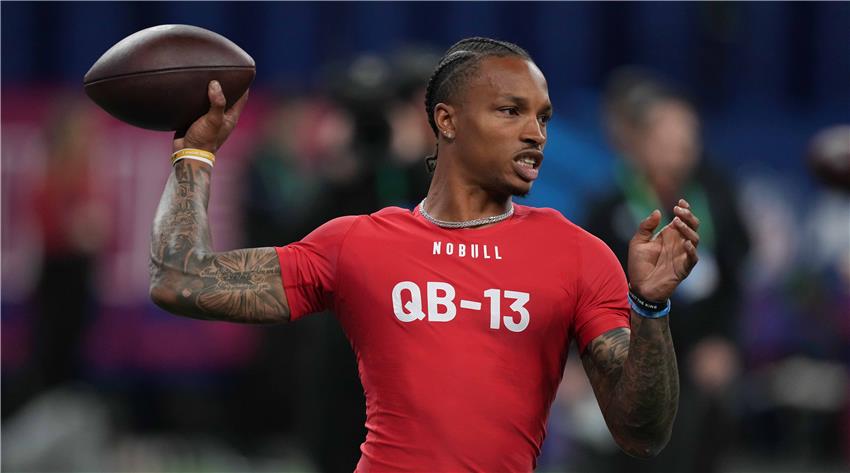
Pro Day Success- Why Players Outperform Their NFL Combine Results
When it comes to evaluating NFL draft prospects, numbers don't always tell the whole story. Nowhere is this more evident than in the often stark differences between a player's performance at the NFL Combine and their showing at their college pro day.
This discrepancy has long been a source of intrigue and debate among fans, scouts, and analysts alike. So why do we often see such variation, and what does it really mean for a player's draft stock?
The Tale of Two Performances
To illustrate this phenomenon, let's start with a striking example. In 2014, Jadeveon Clowney, the eventual first overall pick, ran a blistering 4.53-second 40-yard dash at the NFL Combine. This time was already exceptional for a defensive end of his size. However, at his pro day at the University of South Carolina, rumors circulated that he had clocked in even faster, with some hand-timers recording times as low as 4.43 seconds. While officially unverified, this story highlights the often-dramatic differences between combine and pro day performances.
Former NFL scout Daniel Jeremiah offers insight into why these differences occur: "Pro days are designed for players to succeed. It's their home turf, their schedule, and often their own ball or equipment. It's not uncommon to see improvements across the board."
The Numbers Game
To put this into perspective, let's look at some statistics. A study conducted by the National Football Post analyzed the 40-yard dash times of 195 players who ran at both the combine and their pro days from 2009 to 2011. The findings were eye-opening:
- 62% of players ran faster times at their pro days
- The average improvement was 0.10 seconds
- Wide receivers showed the biggest improvement, averaging 0.12 seconds faster
- Offensive linemen had the smallest gain, averaging 0.04 seconds faster
These numbers might seem small, but in the world of elite athletics, a tenth of a second can make a world of difference.
Home Field Advantage: More Than Just Comfort
The concept of "home field advantage" extends far beyond the comfort of familiar surroundings. Dr. Patrick Rishe, director of the sports business program at Washington University in St. Louis, explains: "There's a psychological element at play. Athletes often perform better in environments where they feel supported and in control. This can lead to measurable improvements in physical performance."
This psychological edge was evident in the case of quarterback Patrick Mahomes. At the 2017 NFL Combine, Mahomes posted a respectable but not jaw-dropping 40-yard dash time of 4.80 seconds. However, at his Texas Tech pro day, he improved to 4.71 seconds. More importantly, he wowed scouts with his throwing session, showcasing the arm talent that would eventually make him one of the NFL's elite quarterbacks.
Mahomes later reflected on the experience: "The combine is a great opportunity, but there's something special about performing in front of your college coaches and teammates. It brings out that extra bit of confidence and energy."
Timing and Preparation: A Crucial Difference
The scheduling of the combine and pro days plays a significant role in performance differences. The combine typically takes place in late February or early March, while pro days are spread out through March and early April. This additional time can be crucial for players to refine their skills and recover from any lingering injuries.
Take the case of Saquon Barkley, the star running back from Penn State. At the 2018 NFL Combine, Barkley put up impressive numbers, including a 4.40-second 40-yard dash. However, he opted not to run the 40 again at his pro day, focusing instead on position drills. Barkley's decision highlights another aspect of pro days – the ability to customize the workout to showcase specific skills.
Barkley explained his strategy: "The combine is great for overall athleticism, but at my pro day, I wanted to show teams the skills that translate directly to playing running back in the NFL."
The "Friendly" Stopwatch Phenomenon
One of the most talked-about aspects of pro-day results is the tendency for times to be faster than those recorded at the combine. This is often attributed to the use of hand-timing at pro days versus the electronic timing used at the combine.
Dr. Richard Stefani, a sports statistician, conducted a study on the difference between hand and electronic timing. His findings showed that hand-timed results were, on average, 0.17 seconds faster than electronically timed results for the same runs. This difference can significantly impact a player's perceived speed and, consequently, their draft stock.
However, NFL Network analyst Daniel Jeremiah cautions against dismissing hand-timed results entirely: "While we need to account for the timing difference, consistently fast times at pro days still indicate speed. Scouts are aware of the discrepancy and factor it into their evaluations."
Custom-Tailored Showcases: Playing to Strengths
Pro days offer players the opportunity to showcase their skills in a more personalized setting. This can be particularly beneficial for players from smaller schools or those who play in unconventional systems.
Carson Wentz, who played at North Dakota State, an FCS school, used his pro day to prove he could compete with top-tier talent. His impressive performance, which included accurate throws in windy conditions, helped solidify his position as a top draft prospect.
Wentz reflected on the importance of his pro day: "Coming from a smaller school, I knew I had to make every opportunity count. My pro day was a chance to show NFL teams that my skills could translate to the highest level."
The Revenge of the Nerves: Second Chances
For some players, the high-pressure environment of the combine can lead to underperformance. Pro days offer a chance at redemption in a more familiar setting.
One notable example is wide receiver Calvin Ridley. At the 2018 NFL Combine, Ridley ran a disappointing 4.43-second 40-yard dash. However, at his Alabama pro day, he improved his time to 4.39 seconds. This improvement, along with a strong showing in receiving drills, helped maintain his status as a first-round prospect.
Ridley later commented on the difference: "The combine can be overwhelming. At your pro day, you're surrounded by teammates and coaches who believe in you. It makes a big difference in how you perform."
Weather Factors: Nature's Role in Performance
While the NFL Combine takes place in the controlled environment of Lucas Oil Stadium, many pro days are held outdoors. This introduces variables like temperature, wind, and field conditions that can significantly impact performance.
In 2019, defensive end Montez Sweat made headlines with his blazing 4.41-second 40-yard dash at the combine. However, at his Mississippi State pro day, he chose not to run again, citing less-than-ideal weather conditions. This decision highlights the strategic thinking that goes into pro day participation.
Former NFL head coach Jon Gruden commented on the impact of weather: "Outdoor pro days give us a chance to see how these guys perform in real-world conditions. It's valuable information, especially for teams that play in outdoor stadiums."
The Full Picture: Combining Combine and Pro Day Data
While the differences between combine and pro day results can be striking, NFL teams use both sets of data in their evaluation process. John Lynch, General Manager of the San Francisco 49ers, explains their approach: "We look at combine results, pro day performances, game film, interviews – everything. It's about building a complete picture of each prospect."
This comprehensive approach is crucial because sometimes pro day performances can be misleading. In 2014, quarterback Johnny Manziel chose to throw at his Texas A&M pro day while wearing shoulder pads and a helmet – unusual for a pro day setting. While he impressed observers, including then-President George H.W. Bush, his NFL career didn't live up to the hype generated by his college performances and pro day showcase.
The Scout's Perspective: Balancing Data and Intuition
NFL scouts are tasked with the challenging job of interpreting the data from both the combine and pro days, while also relying on their trained eye and instincts.
Gil Brandt, former VP of player personnel for the Dallas Cowboys, offers this insight: "Pro days are valuable, but they're just one piece of the puzzle. We're looking at how a player moves, how they interact with teammates, how they respond to coaching. Sometimes, the things you can't measure are the most important."
The Future of Pro Days and the Combine
As analytics continue to play a larger role in football, the way teams use combine and pro day data is evolving. Some teams are placing more emphasis on position-specific drills and real football activities, rather than pure athletic testing.
NFL Network's Lance Zierlein predicts: "I think we'll see pro days become even more specialized in the future. Teams want to see prospects in drills that directly translate to Sunday performance."
Putting it all together: The Pro Day Paradox
The differences between combine and pro day results create a fascinating subplot in the drama of the NFL draft. While pro days often produce more favorable numbers, they're just one factor in a complex evaluation process.
Former NFL executive Michael Lombardi sums it up well: "Pro days are like dessert – they're sweet, but you can't make a meal out of them. The combine, college tape, interviews, and pro days all work together to give us a complete picture of a prospect."
As fans and analysts, it's important to appreciate the pro day performances for what they are – a chance for players to shine in a comfortable environment – while also understanding their limitations. The next time you see a prospect post eye-popping numbers at their pro day, remember that it's just one chapter in their journey to the NFL.
In the end, the true measure of a player's potential isn't found in a 40-yard dash time or a vertical jump measurement, but in their ability to translate their skills to the professional level. The combine and pro days are merely previews. The real show begins when the pads come on and the lights shine brightest on NFL Sundays.
